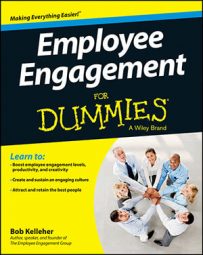An Employee Value Proposition (EVP), which you may think of as your employment brand, is an important element in employee engagement. To be effective, you must also communicate that employment brand, both internally and externally.
If you commit to broadcasting to your employees and to the rest of the world why you’re a swell place to work, in time, they’ll come to believe it (assuming, of course, that it’s true)! In this way, you can engage existing employees and entice the very best recruits, not to mention making the best possible impression on potential new clients!
Essentially, by communicating your employment brand, you foster pride in your company among your workforce. That’s no small thing. Indeed, according to a 2012 report by researchers at Dale Carnegie, “What Drives Employee Engagement,” pride in one’s organization is one of the top three drivers of engagement. (The other two, in case you’re wondering, are satisfaction with one’s immediate manager and trust and belief in senior leadership.)
Unfortunately, most employers spend the majority of their time crystallizing, branding, and communicating what they sell, not who they are.
Your organization’s marketing team should be working hand in hand with your staffing and HR teams to publicize messages about your employment brand, both internally and externally.
Brand internally for employee engagement
There are surveys that rank employers by “Best Employee Benefits.” Surprisingly, the companies that boast the best employee benefit programs are not the companies with the best employee benefits. Instead, the companies with the best programs are the ones that did the best job of communicating the benefits they did offer.
These kinds of studies should make a lasting impression about the power and impact of effectively branding a benefit (or message, initiative, idea, and so on). This is why it’s a big deal when companies conduct an employee engagement survey taking time to communicate to their employees their plans for revealing the results.
Essentially, these companies are “branding” their efforts to disseminate the information. (Sadly, if employees don’t hear updates, they tend to become a tad bit cynical and assume nothing is happening — which can lead to a lack of engagement.)
Repetition is key. There is a reason we connect Clydesdale horses with Budweiser, or talking geckos with Geico. We’ve seen these brands advertise so often that the animals have become synonymous with their products. The same goes for other types of branding as well — including your employment brand.
Sadly, many organizations spend countless hours on their external product branding efforts that they fail to communicate their employment brand on the inside. They underbrand their culture and EVP, while perhaps overbranding their services and products to the outside world.
But the fact is, you must continually remind your employees of your firm’s employment brand, or EVP. Engaged companies will practically scream “We’re great!” over and over to their employees (even if that message is more aspirational than reality based). They know that employees and leaders both want the same thing: to work for a company whose culture rocks.
Brand externally for employee engagement
You’ve identified who you are. You’ve effectively communicated that message internally. Now it’s time for that message to reach the outside world.
This can happen in any number of ways. One is the traditional route — using mainstream marketing and advertising tools to publicize your employment brand. For example, a recent Walmart commercial focuses on a young employee, named Nathaniel, who views his job with the firm as an opportunity to move up in the world, noting that at Walmart, 75 percent of store management started as hourly associates.
He goes on to say that he can use Walmart’s education benefits to obtain a college degree. The ad ends with the tagline, “Opportunity. That’s the real Walmart.” Whatever your feelings about this corporate behemoth, there’s little doubt that the ad effectively communicates an important aspect of the company’s employment brand!
Other avenues for external branding include leveraging “Best Place to Work” surveys and awards and using social media. For more on these tactics, read on.
Leverage “Best Place to Work” surveys and awards
Many people “Best Place to Work” awards are akin to popularity contests. Still, the fact is, companies that pursue “Best Place to Work” status receive many tangible rewards . . . even if they don’t win.
Here’s one: The simple act of filling out a “Best Place to Work” survey provides companies with a quick snapshot of what’s working and what isn’t. Essentially, this acts as a benchmark for the firm’s engagement efforts, and helps illuminate where you should be focusing your energy.
Here’s another: Even if you know you have a lot of work to do before you reach top-50 or top-100 status, just the application process itself can become the push that the leadership team needs to embrace your engagement efforts. Indeed, “Best Place to Work” surveys, which are usually brief and inexpensive, often prompt a full companywide survey to gauge the pulse of your employees.
Being named a “Best Place to Work” also offers irrefutable evidence of your claim that you are, indeed, an elite employer. With “Best Place to Work” status in your back pocket, you can prove to employees and to the outside world that you’re something special.
Accelerate your employment brand using social media
Companies that can articulate their employment brand can take advantage of a great branding accelerator: social media. Enlightened organizations use this new technology to tweet, post, and blog about job openings, new hires, internal thought leaders, company news, and how swell the company is to work for.
Yesterday, a company could get away with telling the world what it does. Today and tomorrow, companies will be able to accelerate their branding by telling the world not only what they do, but also who they are . . . in 140 characters or less!
Of course, the use of social media isn’t just limited to companies. Rank-and-file employees use it, too.

